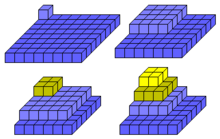In mathematics

65 is the nineteenth distinct semiprime,[1] (5.13); and the third of the form (5.q), where q is a higher prime.
65 has a prime aliquot sum of 19 within an aliquot sequence of one composite numbers (65,19,1,0) to the prime; as the first member' of the 19-aliquot tree.
It is an octagonal number.[2] It is also a Cullen number.[3] Given 65, the Mertens function returns 0.[4]
This number is the magic constant of a 5x5 normal magic square:
This number is also the magic constant of n-Queens Problem for n = 5.[5]
65 is the smallest integer that can be expressed as a sum of two distinct positive squares in two (or more) ways, 65 = 82 + 12 = 72 + 42.[6]
It appears in the Padovan sequence, preceded by the terms 28, 37, 49 (it is the sum of the first two of these).[7]
65 is a Stirling number of the second kind, the number of ways of dividing a set of six objects into four non-empty subsets.[8]
65 = 15 + 24 + 33 + 42 + 51.[9]
65 is the length of the hypotenuse of 4 different Pythagorean triangles, the lowest number to have more than 2: 652 = 162 + 632 = 332 + 562 = 392 + 522 = 252 + 602.[10] The first two are "primitive", and 65 is the lowest number to be the largest side of more than one such triple.[11]
65 is the number of compositions of 11 into distinct parts.[12]
